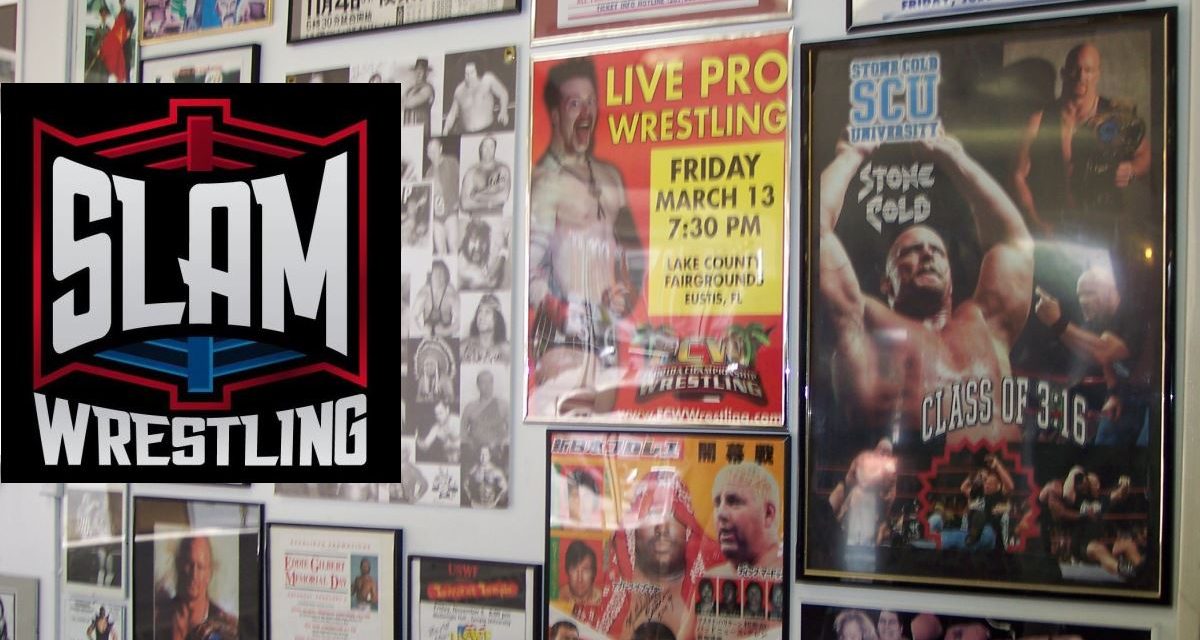WICHITA FALLS, TX – “New York City has the Empire State Building. Paris has the Eifel Tower. Tokyo has the Ribera Steakhouse. And Wichita Falls has ‘The Big Blue,’ home to the Pro Wrestling Hall of Fame,” said Andrew Anderson, beginning the 18th induction ceremony.
A Garden State native and a veteran of the mat wars around the world, Anderson was an interesting choice to be the evening’s emcee, on Saturday, May 18. The PWHF began in Upstate New York, and the Texas-flavored weekend felt “East Coast” again thanks to Anderson, who was light-hearted.
In one notable quip, he claimed the 81-year-old Paul “Butcher” Vachon has one more run in him.
“Hey Tokyo!” Anderson yelled, referring to active star Tokyo Monster Kahagas in audience. “Get ready to put him over!”
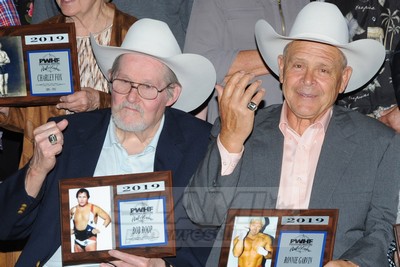
2019 Pro Wrestling Hall of Fame inductees Bob Roop and Ronnie Garvin show off their new rings. Photos by George Napolitano
I’ve been lucky to attend a few of these PWHF ceremonies now, so here is my take on the events on Saturday.
LEGENDARY MAN IN STRIPES
“Okay, guys. You know this is for fun. So take it easy and give them a good show.”
Those words were said by Red Shoes Dugan, a referee’s referee with a granite-like profile and a rock salt gargling voice to match. Those were the official’s instructions prior to Rocky Balboa and Thunderlips meeting in a boxer vs. wrestler match in Rocky III.
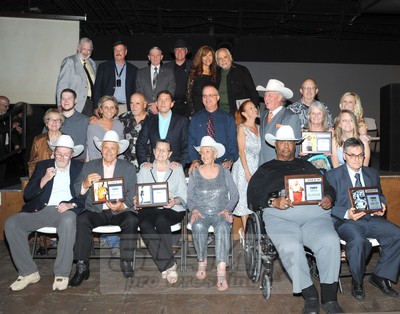
A group shot of the wrestlers in attendance.
Most wrestling historians believe Hulk Hogan’s appearance as Thunderlips in Rocky III not only propelled the Hulkster into household name status, but elevated wrestling into the mainstream consciousness, something the territorial system of wrestling had struggled with on many levels.
That staged scene between Hogan and Sylvester Stallone gave wrestling its proverbial shot in the arm way back in 1982 and Dugan was there to introduce us to a new era in the wrestling business and introduced the masses to Hogan, who, over 35 years later, is still the largest name in the history of the sport.
Dugan was born Raymond J. Gedeon in 1911, and died in 2001. He was a police officer in Santa Monica, California, hence the reason for his stage name. He wore a pair of red shoes, or wrestling boots (made in Mexico) to be correct, thus earning him the moniker early in his career. He first gained notoriety working in the infamous ring of L.A.’s Olympic Auditorium before going to work for different promoters in Japan when said promoters felt they needed to lend more respectability to their product.
His name is synonymous with legendary referees throughout history, but more importantly, he was a member of California’s greatest wrestling fraternity: Blassie, Haggerty, Vargas, Tolos and in that same breath, not a main event wrestler, but a main event referee — Red Shoes Dugan. And now a Hall of Fame member of its Referee division.
CLEVELAND’S FINEST IN AND OUT OF THE RING
Charley Fox toiled in wrestling rings from Evansville to Columbus, Chicago to Atlanta and everywhere else in between throughout the 1920s and ’30s. His popularity throughout these territories landed him in Cleveland in the mid ’20s where to make ends meet, he settled down as a police officer.
While in Cleveland, Fox was instrumental in organizing scholastic wrestling and at the height of his career on May 30, 1930, he met touring World champion, Jim Londos. The match did impressive business at the time, drawing 4,000 fans.
By the mid 1930s, Fox was phased out of competition, and he ran for political office and serving as “councilman at large,” and then he accepted the appointment as Chief of Police in Euclid, Ohio, a position he held from late 1932 until 1938. He retired as a lieutenant from the Euclid police force in 1944 and passed away in 1951 at the age of 60.
His family was on hand to proudly accept Fox’s induction into the Pioneer Division.
TOUGH LADIES
Lillian Ellison, better known to the wrestling universe as The Fabulous Moolah, would correct people whenever they would call ladies wrestling women’s wrestling, Moolah would say in her drawl: “Ladies wrestling sounds so much better than women’s wrestling. Look at us! We ARE ladies of the highest pedigree.”
During the late 1930’s, “ladies” wrestling was never rougher. The combatants were tough as nails — they had to be. The women wrestled prior to the main event to warm up the crowd. It had become common occurrence for bookers to ask the ladies to “take it easy tonight” so as not to draw away from the men on the marquee.
It didn’t matter which territory it was, if ticket sales were down, they brought in the ladies to put asses in seats, mostly as a “one-off” a quick trip through the promotion’s towns. The ladies drew in the fans to see what the main stable of male wrestlers were up to. That was a popular formula in the business from the 1950s all the way to the 1970s. Things have changed, and WrestleMania was main evented by a women’s wrestling bout.
Ann Laverne and others empowered and paved the way for women to get involved in the business. In the mid 1940s, a rookie Mae Young and Laverne beat each other up relentlessly, from town to town, territory to territory. They put their bodies on the line, bashing each other in the mouth, landing stiff kicks to the mid-section, punching each other in the head as hard, if not harder at times, than the men did. These women wanted to prove their worth, they wanted to prove that they were a drawing card and despite helping the promoters out of the red in their quarterly receipts, they were never given top billing or even earned anything close to the purse afforded for main event competitors.
Though Laverne wrestled as one of the top women heels of the golden era and never headlined any cards, she made an impression on fans worldwide. She created heat with the audience that her male counterparts could barely touch. Some of them were jealous, but few as fearless as Ann Laverne. A lady in a man’s sport when women were “the fairer sex” and it was inconceivable to hate them or believe they were “tough.” Laverne died in 1999. Her daughter wrestled as Marie Laverne, and was on hand for her mother’s induction into the Women’s Division.
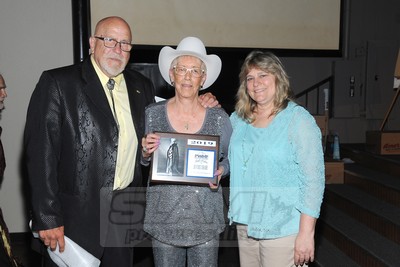
Ted Gordienko, Beverly Shade and Lisa “The Adjuster” Haynes.
The other Women’s Division inductee was on hand. Beverly Shade debuted in Florida in 1957 after being trained by Cowboy Luttrall. One of the few ladies to success outside of Moolah’s camp, she wanted to gain her own reputation rather than ride the coattails of her trainer. She was one of the few competitors to work with Moolah without joining her ranks. She was a former NWA and IWA Women’s tag team champion with her partner, Tracey Richards.
Shade eventually carved a niche as on of wrestling history’s few female promoters, where she also worked as a booker, holding her own creative mind in the business alongside her male equals, and her husband, Billy Blue River.
At the induction upon being presented with her ceremonial “cowgirl” hat, Shade teased, “Save a horse! Ride a cowgirl!” proving she is “one of the boys.”
BARON ITALIANO
When one speaks of the early days of televised wrestling in the 1950s, one must never forget the black and white melees from L.A.’s Hollywood Legion Stadium. The top television star at the time was Gorgeous George. In this writer’s opinion, he was seconded by Baron Michele Leone, an inductee into the Pioneer Era section.
Born in Abruzzo, Italy in 1909, he began his career in the 1920s working in his homeland, in France and even ventured to Argentina. Through his travels, he developed a style that was very unique for the time, especially to an American audience. He utilized intricate holds that would best be described today as an early “lucha” style.
Leone debuted in New York at the Hippodrome for infamous promoter, Jack Pfeffer, in 1938 beginning a run of main event success throughout the area for ten years before relocating to Southern California where he found his greatest success.
Baron became a huge drawing card throughout the 1950s. His matches with Antonino Rocca wowed wrestling fans along the West Coast and throughout the rest of the country on a new gadget called “television.” His style and character were perfect for early TV wrestling. He knew how to entertain and his matches stand the test of time and are as entertaining today as they were over sixty years ago.
I encourage you to look up his matches online. You’ll never be disappointed in the Baron.
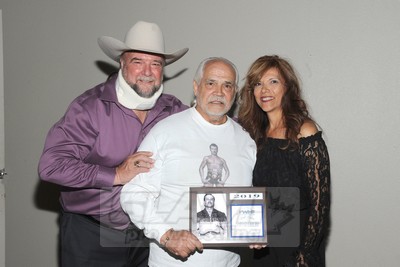
Cowboy Johnny Mantell with two of Gory Guerrero’s children, Mando Guerrero and Linda Guerrero Rodriguez.
DYNASTIES REPRESENTED
Salvador Guererro Quesada, more famously known as Gory Guererro, gained a reputation as one of the most respected Mexican-American wrestlers of the 20th century. He is the patriarch to one of wrestling’s greatest and most innovative families, and four of his sons became big stars: the late former World junior heavyweight champion, Chavo Sr. (whose own son, Chavo Jr., became a star too); the high-flying, sometimes masked, Hector; the late, iconic leader of Latino Heat, Eddie Guerrero; his second oldest son, Mando, who was in Wichita Falls to accept induction to the Hall in the International Division on his father’s behalf.
Clad in a maroon velvet robe previously worn by his father, Mando waxed sentimentally about one of wrestling’s most liked and talented Latino wrestler ever. Gory was a trainer, an accomplished promoter and a true innovator inside the ring. A household name and hero to the masses in El Paso, Gory introduced moves to American audiences that had never been seen before.
Mando was just as talented as his brothers. He mainly wrestled the California circuit and upon the suggestion of “Judo” Gene LeBell, he pursued a career as a Hollywood stuntman. He worked on hundreds of cinematic projects, including many memorable wrestling scenes in several films.
The other dynasty being recognized was the Hart Family, with Owen Hart inducted posthumously into the Modern Era division. It can’t be stressed simply enough that Owen was taken from us too soon in 1999. The youngest of the Hart siblings which included brother Bret, he carved his niche in the business as a high flyer in the ’90s. Though often in the shadow of his legendary older brother and the even larger shadow cast by the glory of the Hart Family of Calgary in and of themselves, Owen developed his own fan base quite separate from his family and as has been well documented, he was a happy-go-lucky guy who loved pulling pranks (referred to as “ribs” in wrestling) on friends, family and co-workers. He was always someone who could bring a smile to your face.
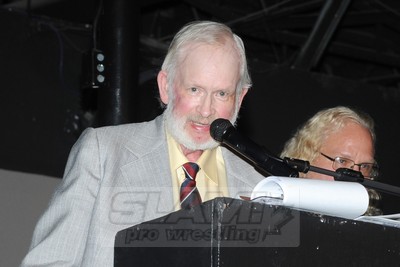
Bob Johnson talks about Owen Hart.
Representing the Hart Family, and accepting induction on Owen’s behalf, was close family friend and confidant, Bob Johnson. If there were an adopted member of the Hart Family, it would be Bob. He wore a pair of cowboy boots one size too big given him by family patriarch, Stu.
“Well, Bob,” I always say. “Those are big boots to fill.”
Johnson was introduced to the family while managing a movie theater in Winnipeg. “It was 1978,” Bob recounted. “Sylvester Stallone’s wrestling epic, Paradise Alley was debuting at the theater. We thought it would be a good idea to contact Stu and invite wrestlers down as a bit of a publicity stunt. That’s when I met a 13-year-old Owen Hart.” No one could have represented the family better.
In the words of Owen’s brother Bruce, who coincidentally co-hosts the Hart Beat Radio podcast with Bob Johnson: “[Owen’s] talent rose above all the gimmicks he was given and he was able to shine with so many great athletes.”
This week marked the 20th anniversary of Owen’s tragic death. His career and death are well documented online. His matches, especially those with his brother, Bret, in 1994 were instant classics, epic duels. While revisiting Owen’s matches, it’s difficult not to ponder, “What if?”
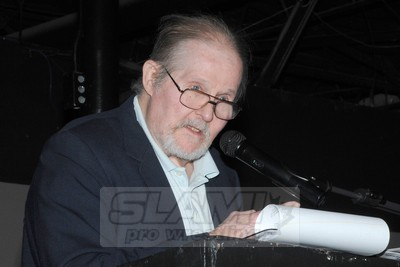
Bob Roop.
THE UNDERRATED SUPERSTARS
Mention the name Bob Roop to any wrestling historian and the immediate reply would be, “He’s a tough SOB”.
Born Robert Michael Roop, July 22, 1947 in Blacksburg, Virginia. His accomplished career as a wrestler began in his adolescence when he began wrestling as a freshman. Undefeated in his senior year, he went on to win the Michigan State championship. After a stint in the army, Roop returned to the collegiate ranks at Southern Illinois University in Carbondale where he was a four-time NAAU All-American and added the title Olympian to his resume when he competed at the 1968 Olympic Games in Mexico City, placing seventh among the world’s greatest.
While in Florida in 1969, Roop met legendary promoter and wrestler, Eddie Graham. Proficient as both a heel and a face and flexible enough to work mid-card all the way up to main event status, he used the “Olympian” moniker throughout the 1970s and ’80s as he worked across several of the territories nationwide; however, sadly, after injuring his neck in a car accident in 1988, Roop retired from active competition, concentrating on the training and tutelage of aspiring superstars. He is a stalwart supporter of the PWHF, and was inducted as a part of the Territory, Journeyman, Colleague Division.
While on the stage accepting his honor, Roop vowed to attend every reunion with his son until he is physically unable to attend. “I’ll be in a box, before I miss a weekend like this.”
The other Modern Era Inductee, Ronnie Garvin, is a name synonymous with the NWA. He upset Ric Flair for the prestigious strap at age 42 in 1987. The victory shocked the wrestling world! Though a credible challenger, nobody thought he would capture the gold that night in Detroit.
A powerful presence in the ring, his two trademarks were the “Garvin Stomp” and of course, his “Hands of Stone.” While his opponent lay prone on the mat, he’d stomp his boots across the entirety of their body, travelling from ankle to knee to sternum to shoulder, making a tour of his adversary’s body and if that wasn’t enough, look out for that right hand! That taped fist could come out of anywhere at any moment and knock his opponent out once and for all.
He was a consistent star on both Georgia Championship Wrestling and World Championship Wrestling, both major programs on Superstation WTBS. During those days of the expansion of wrestling through cable television, it was tough not to turn on a show without seeing him. His reputation is that of a consummate gentleman in and out of the squared circle. It was a pleasure for everyone in attendance to meet “Hands of Stone” live and in person.
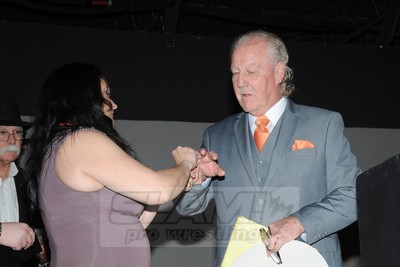
Randy Rose accepts his ring from K. Kreymer Downs.
THE MIDNIGHTS
The fans shortened their name in casual conversation: “Hey! You see the Rock ‘N’ Rolls and the Midnights on Saturday?”
Upon reflection, they were probably the greatest tag team dynasty, and a deserving team in the Tag Team Division. The first incarnation of the Midnight Express formed in Alabama in 1980 and consisted of Randy Rose and “Loverboy” Dennis Condrey. Eventually, Norvell Austin joined to make the group a trio. This lasted until Condrey left for Mid South Wrestling in 1984.
The second incarnation happened when Condrey and “Beautiful” Bobby Eaton teamed to form a new version managed by Jim Cornette in Mid South Wrestling, eventually winning the NWA World tag team titles on multiple occasions; however, by 1987, Dennis unexpectedly left and went to the AWA where under the management of Paul Heyman, teamed once again with Randy Rose to reform the “Original” Midnight Express. This faction invaded WCW in 1988, attacking Eaton, Cornette and newest Midnight, “Sweet” Stan Lane, formerly of the Fabulous Ones. It became one of the hottest feuds on television at the time.
On the stage, Rose noted that WCW’s booker, Dusty Rhodes, fibbed. “Dusty said, ‘Come to WCW. You’ll make more money.’ That was untrue,” recalled Randy Rose to a roar of laughter at the ceremony. (The rest of the Midnights — Cornette, Eaton, Condrey and Lane — were at a conflicting event in Richmond, Virginia.)
TALLY-HO!
That was the catch phrase of one of Great Britain’s greatest exports, Lord James Blears. Born in Lancashire, England in 1923, by 1946, he pursued his future in the business and landed in New York City becoming friends and roommates with Stu Hart and Sandor Kovacs. In those early years he wrestled as Jan Blears, but made a leap in his career on early wrestling television in the 1950s by developing the “Lord” moniker, that of a pompous British aristocrat. Teaming with the equally pompous Lord Carlton, they had grandmother throwing balls of yarn at television sets across the nation. Fittingly, he was a Television Era inductee.
Blears frequently wrestled for Rikidozan and All Japan Wrestling since the late 1950s and during the 1960s he moved to Hawaii and eventually became an agent for talent working in the Land of the Rising Sun. He is also remembered for his work as a commentator for his pal, Verne Gagne’s AWA during the 1980s. A well-respected, intelligent character, the Lord passed in 2016 at the age of 92.
WALLY CARIBOO
Jesse “The Body” Ventura would refer to the AWA promoter Wally Karbo as Wally CARIBOO. Karbo was from a generation of old-school promoting, beginning with his first event in Minneapolis in 1936. Later, in 1960, Karbo partnered with Verne Gagne in the AWA and for the next few decades, they dominated the Midwest market. Wally sold his interests to Gagne in 1985. With a reputation as a very friendly, approachable man, often referring to people as “pal,” Wally went to that wrestling and boxing club in the sky in 1993. He was inducted in the Executive Division.
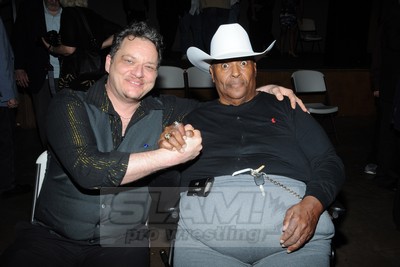
Carmine DeSpirito and Abdullah the Butcher.
A STORY AND $8,000
He’s Abdullah the Butcher. His friends call him Abby. In wrestling, there used to be wild men who roamed from territory to territory and town to town, raising hell and shedding blood. Names like the (Original) Sheik, Bruiser Brody, Bull Curry, Pampero Firpo and, of course, Abby. Last year’s honoree, Firpo, terrorized (and entertained) hordes of fans from the Garden to the Olympic and everywhere in between. Many are not aware, but Abby worked the Garden as a young man in the 1960s as well.
His career began in Windsor, Ontario, and he quickly gained a reputation for his bloodthirsty antics. Blood sold tickets in wrestling. It’s been said several times before, “red turns to green” and Abby was an attraction that put asses in seats. He simply terrorized the world of wrestling.
From his battles with Carlos Colon in Puerto Rico, or the three decades worth of bloodbaths he had with the Sheik, Abby gave the fans what they wanted — blood. His most famous adversary was the equally scary, Bruiser Brody. Abby and Brody tore the house down (sometimes literally) wherever they faced from World Class Championship Wrestling in Dallas to All Japan in Tokyo to Puerto Rico, as well.
When I was first breaking into the business in 1990, I witnessed the carnage first hand. I was a manager with maybe three years in the business and I was booked for my first overseas trip to Athens, Greece, as “The Creator.” American pro wrestling had been seen on television there for a couple years prior, but this was the first time they were seeing a live show. The arena was packed to the rafters: 8,000 people. I was given the dubious task of being Abby’s manager for the night against his opponent, Jules Strongbow.
The match went for about 15 minutes. They left the ring and ventured into and around the crowd and the fans became unglued. They had never witnessed anything like this in their lives. As the action returned to the ring, both men were bloodied to the waist. “The Mad Man from Sudan” left a hapless, Native American bleeding in the ring like a gutted deer. There was no decision to the match. The fans were shocked. Abby and I stormed back to the locker room in a hurry and the fans went silent. In wrestling jargon, it’s called “white heat.” You don’t want white heat. That’s the wrong kind of heat. We rushed down the aisle, escorted by security all the way to Abby’s locker room. For a 19-year-old rookie, I was scared, but confident I would be protected.
“Where’s my belt?” Abby asked as he sat down.
“It must still be at the timekeeper’s table,” I uttered.
Abby pointed at the door. “You’re my manager,” he said. “You need to go out there and get my belt.”
“Yes sir.” What would anyone else do in my position? I proceeded to make my way to the ring.
The people in the audience were pissed. The silence we left them with had slowly turned to rage and everybody began rising to their feet, making their way down the stadium seats. Armed police with billy clubs were holding the mob back. I snatched the belt from the ringside table. Then I remembered what Abby had told me about crowds like this: First, don’t run; second, don’t turn your back to the crowd — walk backwards through the locker room curtain; third, keep your elbows at your side to avoid a fatal knife wound; finally, always look those fans directly in the eyes.
I raised the belt above my head and the crowd began to swarm the entranceway. All of that advice came in handy, to say the least. As I backed through “the curtain,” two 20-foot high iron doors that slammed shut in front of me, I could see a few fans had jumped the railing as security did their best, swinging night sticks to control the scene.
Later, I realized I escaped a near riot. Those huge iron doors were closed just as if a riot broke out at a soccer game.
I returned to the locker room, gave him his belt and took a deep breath.
“Abby, I was almost killed out there!” I protested.
“Calm down,” he said. “We only did our jobs.”
We had to wait for an hour or two in the building after the show before we could retire to the safety of our hotel because a throng of angry fans were waiting outside for us to leave. Abby protected me. There was no way he or I were leaving until every last fan was gone.
When I saw him again in Wichita Falls, I thanked him.
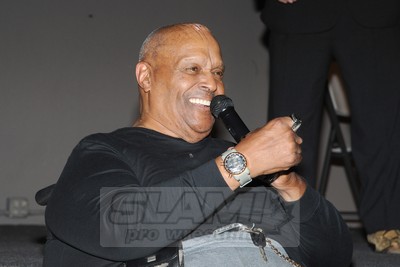
Abdullah the Butcher speaks.
As noted wrestling photographer George Napolitano said as he introduced Abby for his induction: “He gave pleasure to the fans and pain to wrestlers.” Abby accepted the award and the ceremonial cowboy hat before his acceptance speech. He spoke of the WWE Hall of Fame where he was inducted in 2011. When he was given the ring, he said he refused to show him putting the ring on in front of the camera because he never worked for the WWE. He sold the ring on eBay for $8,000. Of the PWHF and his new ring, he said it will never leave his finger. Abby was controversial for 55 years, why should he be any different today? There’s only one and there will only ever be one Abdullah the Butcher.
All in all, the PWHF induction weekend makes for a worthwhile trip every year, and I strongly encourage you to go see it — and it’s exactly as promoted, a real, bricks and mortar building, in Big Blue, in the heart of Wichita Falls.
Special thanks to Cowboy Johnny Mantell and K. Kreymer Downs for their hospitality and hard work. The PWHF is a 24/7 responsibility. Engulfing one’s life with the love of wrestling can be overbearing at times. I speak from experience and your focus on preserving the history of wrestling at any cost. Lastly, the Texas BBQ was incredible!
RELATED LINK
